Sunderland AFC
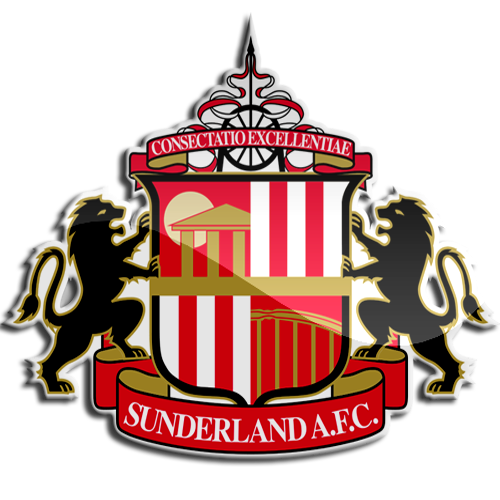
Details
- Name: Sunderland Association Football Club
- Nickname: The Black Cats / Mackems
- Founded: 1879 (as Sunderland and District Teachers AFC)
- Renamed: 1880 to Sunderland AFC
- Ground: Stadium Of Light
- Ground capacity: 48,707
History
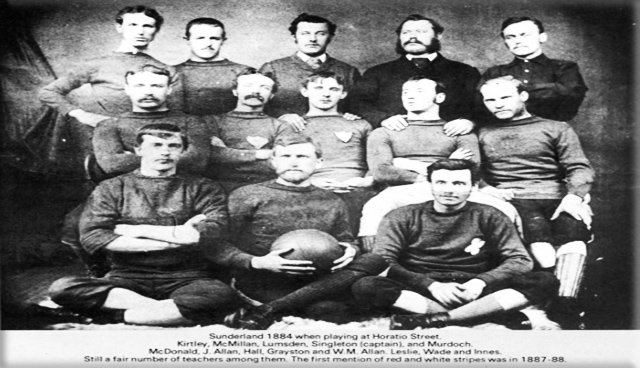
Early years and league triumphs
Founded in 1879 as 'Sunderland and District Teachers A.F.C.' by schoolmaster James Allan, Sunderland joined The Football League for the 1890–91 season. They replaced Stoke, who had failed to be re-elected, becoming the first new club to join the league since its inauguration in 1888.
During the late 19th century, they were declared the "Team of All Talents" by William McGregor, the founder of the league, after a 7–2 win against Aston Villa. Sunderland won the league championship in the 1891–92 season, one season after joining The Football League. The club's 42 points were five clear of nearest rivals Preston North End, and this performance led The Times to describe the players as "a wonderfully fine team". Sunderland successfully defended the title the following season, aided by centre forward Johnny Campbell, who broke the 30-goal mark for the second time in consecutive seasons. In the process, they became the first team to score 100 goals in a season, a feat not matched until 1919–20, when West Bromwich Albion set a new record.
Sunderland came close to winning a third successive league championship in the 1893–94 season, finishing second behind Aston Villa. However, they regained the title in the 1894–95 season, ending the season five points ahead of Everton. After winning the English League Championship, Sunderland played against Heart of Midlothian, the champions of the Scottish League, in a game described as the Championship of the World title match. Sunderland won the game 5–3 and were announced "Champions of the world". Sunderland came close to winning another league title in the 1897–98 season, when they finished as runners-up to Sheffield United. That season was their last at Newcastle Road, as they moved to Roker Park the following season. After coming second in 1900–01, the club won their fourth league title in the 1901–02 season, beating Everton by a three-point margin.
In 1904, Sunderland's management was embroiled in a payment scandal involving player Andrew McCombie. The club was said to have given the player £100 (£9.4 thousand today) to help him start his own business, on the understanding that he would repay the money after his benefit game. However, McCombie refused to repay the money, claiming it had been a gift. An investigation conducted by the Football Association concluded that the money given to McCombie was part of a "re-signing/win/draw bonus", which violated the Association's rules. Sunderland were fined £250 (£23.5 thousand today), and six directors were suspended for two and a half years for not showing a true record of the club's financial dealings. Sunderland manager Alex Mackie was also suspended for three months for his involvement in the affair.
Further league championship titles
On 5 December 1908, Sunderland achieved their highest ever league win, against north-east rivals Newcastle United. They won the game 9–1; Billy Hogg and George Holley each scored hat-tricks. The club won the league again in 1913, but lost their first FA Cup final 1–0 to Aston Villa, in a very tough loss. This was the closest the club has come to winning the league title and the FA Cup in the same season. Two seasons later the First World War brought the league to a halt. After the league's resumption, Sunderland came close to winning another championship in the 1922–23 season, when they were runners-up to Liverpool. They also came close the following season, finishing third, four points from the top of the league. The club escaped relegation from the First Division by one point in the 1927–28 season despite 35 goals from Dave Halliday.
Sunderland's 1937 FA Cup winning side
The point was won in a match against Middlesbrough, and they finished in fifteenth place. Halliday improved his goal scoring to 43 goals in 42 games the following season, an all-time Sunderland record for goals scored in a single season.
The club's sixth league championship came in the 1935–36 season, and they won the FA Cup the following season, after a 3–1 victory against Preston North End at Wembley Stadium. The remainder of the decade saw mid-table finishes, until the league and FA Cup were suspended for the duration of the Second World War. Some football was still played as a morale boosting exercise, in the form of the Football League War Cup. Sunderland were finalists in the tournament in 1942, but were beaten by Wolverhampton Wanderers.
For Sunderland, the immediate post-war years were characterised by significant spending; the club paid £18,000 (£555 thousand today) for Carlisle United's Ivor Broadis in January 1949. Broadis was also Carlisle's manager at the time, and this is the first instance of a player transferring himself to another club. This, along with record-breaking transfer fees to secure the services of Len Shackleton and Welsh international Trevor Ford, led to a contemporary nickname, the "Bank of England club". The club finished third in the First Division in 1950, their highest finish since the 1936 championship.
Financial troubles and three cup finals
The late 1950s saw a sharp downturn in Sunderland's fortunes, and the club was once again implicated in a major financial scandal in 1957. Found guilty of making payments to players in excess of the maximum wage, they were fined £5,000 (£105,000 today), and their chairman and three directors were suspended. The following year, Sunderland were relegated from the highest division for the first time in their 68-year league history.
Sunderland's absence from the top flight lasted six years. The club came within one game of promotion back to the First Division in the 1962–63 season. Sunderland required only a draw in their final game against promotion rivals Chelsea, who had another game left to play after this match, to secure promotion. However, they were defeated, and Chelsea won their last game 7–0 to clinch promotion, finishing ahead of Sunderland on goal average. After the close call in the previous season, the club was promoted to Division One in 1964 after finishing in second place. Sunderland beat Charlton Athletic in the final stages of the season, where they clinched promotion with a game to spare. At the end of the decade, they were again relegated to the Second Division after finishing 21st.
Sunderland won their last major trophy in 1973, in a 1–0 victory over Don Revie's Leeds United in the FA Cup Final. A Second Division club at the time, Sunderland won the game thanks mostly to the efforts of their goalkeeper Jimmy Montgomery, who saved two of Leeds shots at goal in quick succession, one being from hot-shot Peter Lorimer. Ian Porterfield scored a volley in the 30th minute to beat Leeds and take the trophy. Since 1973 only two other clubs, Southampton in 1976, and West Ham United in 1980, have equalled Sunderland's achievement of lifting the FA Cup while playing outside the top tier of English football.
By winning the 1973 FA Cup Final, Sunderland qualified for the UEFA Cup Winners' Cup, the club's only appearance in European competition to date. Sunderland beat Vasas Budapest 3–0 on aggregate, and were drawn against Lisbon club Sporting in the second round. They won the first leg at Roker Park 2–1 but were defeated 2–0 in the away leg, and were knocked out of the competition 3–2 on aggregate. After spending six seasons in the Second Division, Sunderland were promoted to Division One in the 1975–76 season; they topped the table over Bristol City by three points. However, Sunderland were relegated the following season back into Division Two, without their FA Cup Final winning manager Bob Stokoe, who had resigned because of health problems at the start of the season. The club celebrated its 100-year centenary in the 1979–80 season with a testimonial against an England XI side, which they lost 2–0.
Sunderland appeared in their first League Cup final in 1985, but lost 1–0 to Norwich City. In 1987, Sunderland saw one of the lowest points in their history, when they were relegated to the Third Division of the English league for the first time. Under new chairman Bob Murray and new manager Denis Smith, the club was promoted the following season. In 1990, they were promoted back to the top flight in unusual circumstances. Sunderland lost to Swindon Town in the play-off final, but Swindon's promotion was revoked after the club was found guilty of financial irregularities and Sunderland were promoted instead. They stayed up for one year before being relegated on the final day of the following season.
Sunderland's next outing in a major final came in 1992 when, as a Second Division club, they returned to the FA Cup final. There was to be no repeat of the heroics of 1973, as Sunderland lost 2–0 to Liverpool. The early 1990s was a turbulent period for the club.
Recent highs and lows
In 1995, they faced the prospect of a return to the third-tier of English football. Peter Reid was brought in as manager, and quickly turned things around. Reid's time in charge had a stabilising effect; he remained manager for seven years. After promotion from Division One in the 1995–96 season, Sunderland began their first season in the Premier League, but finished third from the bottom and were relegated back to the First Division. In 1997, Sunderland left Roker Park, their home for 99 years. Bearing fond memories of the stadium, former Sunderland player Len Shackleton said, "There will never be another place like Roker".The club moved to the Stadium of Light, a 42,000-seat arena that, at the time, was the largest stadium built in England after the Second World War.
The capacity was later increased to 49,000. Sunderland returned to the Premier League as First Division champions in 1999 with a then-record 105 points. Sunderland's 1999–2000 season started at Stamford Bridge, where Chelsea beat them 4–0. However, in the return match later in the season Sunderland turned the tables on Chelsea, avenging their 4–0 defeat with a 4–1 win at the Stadium of Light. Sunderland also achieved a 2–1 victory over rivals Newcastle United at St. James' Park, a result which helped bring about the resignation of Newcastle's manager, Ruud Gullit. At the end of the season Sunderland finished seventh, with Kevin Phillips winning the European Golden Shoe in his first top-flight season, scoring 30 goals.
Another seventh place finish in the 2000–01 season was followed by two less successful seasons, and they were relegated to the second-tier with a then-record low 19 points in 2003. Former Ireland manager Mick McCarthy took over at the club, and, in 2005, he took Sunderland up as champions for the third time in less than ten years. However, the club's stay in the top flight was short-lived; as Sunderland were once again relegated, this time with a new record-low total of 15 points. McCarthy left the club in mid-season, and he was replaced temporarily by former Sunderland player Kevin Ball. The record-low fifteen-point performance was surpassed in the 2007–08 season by Derby County, who finished on eleven points.
Drumaville Consortium takeover and Premiership stability
Following Sunderland's relegation from the Premier League, the club was taken over by the Irish Drumaville Consortium, headed by ex-player Niall Quinn, who appointed former Manchester United captain Roy Keane as the new manager. Under Keane, the club rose steadily up the table with an unbeaten run of 17 games to win promotion to the Premier League, and were named winners of the Championship after beating Luton Town 5–0 at Kenilworth Road on 6 May 2007.
The club's form in the 2007–08 season was better than during their last season in the Premier League, as they finished 15th with 39 points. Following an inconsistent start to the 2008–09 season Keane resigned, to be replaced by coach Ricky Sbragia as caretaker until the end of the season. After keeping Sunderland in the Premier League, Sbragia stepped down from his managerial post. Meanwhile off the pitch, Irish-American tycoon Ellis Short completed a full takeover of the club from the Irish Drumaville Consortium, and Steve Bruce was announced as the new manager on 3 June.
One of Bruce's first signings, Darren Bent, cost a club record fee of £10 million. Sunderland started their first season under Bruce strongly, including victories against Arsenal and Liverpool, but then went 14 matches without a win over the winter, eventually finishing the 2009–10 season 13th. Sunderland completed the signing of Ghana international Asamoah Gyan in August 2010 for a fee around £13 million, becoming their new record transfer fee. Sunderland started the next season strongly, this time with a seven match unbeaten run against teams including Manchester City, Liverpool, Arsenal and Manchester United.
However, the run was ended with a 5–1 defeat to local rivals Newcastle United on 31 October 2010. Sunderland bounced back with another good run, the highlight being a 3–0 victory against Chelsea at Stamford Bridge. This run left Sunderland challenging for a European qualification place by the end of 2010. However, striker Darren Bent left Sunderland for Aston Villa in January 2011 in a deal potentially worth £24 million (a record transfer fee received for the club). Following Bent's departure Sunderland suffered a mid-season slump and finished 10th — their highest top-flight finish for 10 years.
In July 2011, Sunderland signed a partnership agreement with Ghanaian club Asante Kotoko. Ellis Short replaced Quinn as chairman in October 2011, with Quinn becoming Director of International Development. Bruce was sacked on 30 November 2011, following a poor run of results, and was replaced by Martin O'Neill. O'Neill made an instant impact, with Sunderland taking 13 points from a possible 18 in his first six games in charge, including a 1–0 defeat of leaders Manchester City on New Year's Day 2012. O'Neill was named the Premier League Manager of the Month for December. Sunderland also beat Peterborough United in the Third round of the FA Cup, and advanced to the Fifth Round after an extra time winner from Stéphane Sessègnon in a replay with Middlesbrough. In the fifth round, the Black Cats defeated Arsenal 2–0 to reach the quarter-finals for the first time since 2004.
On 20 February 2012, Niall Quinn left the club with immediate effect. On his departure, Quinn said: "Everything is in place for Sunderland to really make a statement, which was always my aim." On 24 August 2012, Sunderland announced the signing of Steven Fletcher from Wolverhampton Wanderers for a fee of £14 million and England international winger Adam Johnson from Manchester City. Despite this, Sunderland endured a difficult start to the season, with their first victory not coming until late September against Wigan. Despite the £5 million signing of Danny Graham in January, Sunderland suffered a further slump, taking just 3 points from eight games, and with the threat of relegation looming, O'Neill was sacked on 30 March, following a 1–0 home defeat by Manchester United.
Paolo Di Canio was announced as O'Neill's replacement the following day, bringing his own backroom staff. The appointment prompted the immediate resignation of club Vice Chairman David Miliband due to Di Canio's "past political statements". The appointment of Di Canio also sparked opposition from the Durham Miners' Association, which threatened to remove one of its mining banners from Sunderland's Stadium of Light, which is built on the former site of the Wearmouth Colliery, as a symbol of its anger over the appointment. The background to the opposition was past statements made by Di Canio supporting Fascism. The threat by the Durham Miners' Association was removed after meeting with the management of the club.
After a 2–1 loss at Chelsea, Di Canio's second match in charge saw Sunderland beat Newcastle 3–0 at St James' Park in the Tyne Wear Derby and their first win at St James Park since November 2000. Sunderland then beat Everton at home the following weekend. Although they failed to win again that season, Wigan Athletic's defeat at Arsenal guaranteed the Black Cats' survival with one game to go. Over the summer, the club appointed Italian former agent Roberto De Fanti as the club's first director of football. This prompted an overhaul with 14 new players joining the club, although Simon Mignolet and Stephane Sessegnon left the club (to Liverpool and West Bromwich Albion respectively).
After a run of one draw and four defeats in the opening five league games of the 2013/14 season, Di Canio was fired from the club. Gus Poyet was announced as his replacement on 8 October 2013. Despite Sunderland losing 4–0 at Swansea in his first game in charge, Poyet brought a turnaround in Sunderland 's fortunes as they brought their way back into contention for survival with wins against Newcastle, Manchester City and Everton, before thrashing Fulham 4–1 (with Adam Johnson scoring the first hat trick from a Sunderland player since 2010). Poyet also led Sunderland to the Capital One Cup final against Manchester City after a dramatic penalty shootout win at Manchester United in the semi-final.
This the first time Sunderland had reached a major cup final in 21 years. Sunderland were defeated 3–1 by City in the final, depite leading 1–0 at half time through a Fabio Borini goal. Following the final, Sunderland suffered a dreadful run of form, with six defeats and a draw from the following seven matches, to leave the club facing relegation to the Championship after seven seasons in the Premier League. Following a 5–1 defeat at Tottenham, manager Gus Poyet stated the club needed "a miracle" to stay up, and Sunderland sat bottom of the table with 6 games remaining, 7 points adrift. However, they drew 2–2 at Manchester City and then defeated Chelsea 1–2, becoming the first side to beat Chelsea at Stamford Bridge in the Premier League under Jose Mourinho, ending a streak of 77 games over two spells. The Black Cats went on to win their next 3 games, against Cardiff (4–0), Manchester United (0–1) and West Bromwich Albion (2–0) to avoid relegation with a game to spare.
Colours and crest
Sunderland played in an all blue strip from their formation until 1884, when they adopted a red and white halved strip. They assumed the current strip of red and white stripes in the 1887–88 season. Their badge included a ship, the upper part of the Sunderland coat of arms, a black cat, and a football in front of Sunderland's red and white stripes. In 1977 the badge was changed, but still included the ship, football and the background of red and white stripes.
This badge was used until the relocation from Roker Park to the Stadium of Light. To coincide with the move, Sunderland released a new crest divided into four quarters; the upper right and lower left featured their traditional red and white colours, but the ship was omitted. The upper left section features the Penshaw Monument and the lower right section shows the Wearmouth Bridge. A colliery wheel at the top of the crest commemorates County Durham's mining history, and the land the Stadium of Light was built on, formerly the Monkwearmouth Colliery. The crest also contains two lions, the black cats of Sunderland, and a banner displaying the club's motto, Consectatio Excellentiae, which means "In pursuit of excellence".
After a poor run of form with just one win in twelve games, Gus Poyet was sacked by Sunderland on 16 March 2015.
Dick Advocaat was given the role of Head Coach on March 17th 2015. On 27 May 2015, after securing Sunderland's Premier League survival, Advocaat informed the club he would not stay on as manager, but reversed his decision to retire on 4 June 2015, signing a one-year contract with Sunderland. However after 8 league games, Advocaat resigned on 4th October leaving the club to find a new manager.
Sam Allardyce was appointed the next manager in October 2015, and secured a 3–0 victory over Newcastle Utd in his second game, giving the club a record beating six wins in a row against their local rivals.
Allardyce earned praise for his management of Sunderland from some pundits, particularly for his organized approach and emphasis on a strong defence.
However, following England's disappointing performance at Euro 2016, on 22 July 2016 Allardyce was appointed the new England manager, replacing Roy Hodgson.
The following day, David Moyes was announced as Allardyce's replacement as Sunderland manager.
At the end of the 2016-17 season, Sunderland were relegated to the EFL Championship for the first time in ten years.
After the match, Moyes stated that he would like to remain as manager. However on May 22, 2017, one day after the end of the Premier League season, Moyes resigned as Sunderland manager.
On 29 June 2017, Simon Grayson was named as the new manager signing a 3 year deal.
Following a poor run of form in the 2017–18 EFL Championship season, manager Simon Grayson was sacked after a 3-3 draw against Bolton Wanderers Sunderland was managed by caretaker manager Robbie Stockdale until the appointment of former Wales head coach Chris Coleman on a two-and-a-half year deal, announced on 19 November 2017.
In April 2018, after a second consecutive relegation, this time to League One,[104] the club was sold to a group led by Stewart Donald, chairman of Eastleigh F.C. and Coleman was released from his contract.
St Mirren manager Jack Ross was appointed as manager in May 2018 to take charge of what is only the club's second ever season in the third flight of the English football league system.
Honours
- First Division: (level 1) 1891–92, 1892–93, 1894–95, 1901–02, 1912–13, 1935–36
- Second Division/First Division/Championship: (level 2) 1975–76, 1995–96, 1998–99, 2004–05, 2006–07
- Runners-up : 1963–64, 1979–80 Promotion (1): 1989–90
- Third Division: (level 3) 1987–88
- FA Cup: 1937, 1973
- Charity Shield: 1936
- Sheriff of London Charity Shield: 1903
- BBC Sports Personality Team of the Year Award: 1973
- Football World Championship: 1895

Jack Ross

The Facts
Sunderland Association Football Club is an English professional football club based in Sunderland that plays in the Barclays Premier League.
Since its formation in 1879, the club has won six First Division titles—in 1892, 1893, 1895, 1902, 1913, and 1936, the FA Cup twice, in 1937 and 1973 and the FA Community Shield in 1936.
They were also Football League Cup finalists in 1985 and 2014.
Sunderland won their first FA Cup in 1937 with a 3–1 victory over Preston North End, and remained in the top league for 68 successive seasons until they were relegated for the first time in 1958.
Sunderland's most notable trophy after the Second World War was their second FA Cup in 1973, when the club secured a 1–0 victory over Leeds United.
The team has won the second tier title five times in that period and the third tier title once.
Sunderland play their home games at the 48,707 capacity all-seater Stadium of Light having moved from Roker Park in 1997.
The original ground capacity was 42,000 which was increased to 49,000 following expansion in 2000.
Sunderland have a long-standing rivalry with their neighbouring club Newcastle United, with whom they have contested the Tyne – Wear derby since 1898.
Since their establishment in the Premier League in 2007, Sunderland have become one of the world's wealthiest football brands, being valued at USD $93 million in 2014, 31st in the world overall.
For further information check out their Official website
Roker Park Stadium
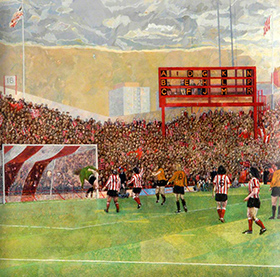
- Tennants: Sunderland A.F.C. (1897 – 1997)
- Capacity: 22,500
- Opened: 1897 - Closed 1997
Roker Park was an English football stadium situated in Roker, Sunderland. The stadium was the home of the English football club Sunderland A.F.C. from 1897 to 1997 before the club moved to the Stadium of Light. Near the end of the stadium's history, its capacity was around 22,500 with only a small part of the stadium being seated. The stadium's capacity had been higher in previous years, attracting a record crowd of 75,118.
History
In the 1890s, the then Sunderland chairman and his brother decided to build a bigger ground for the club, to replace what was then the club's current ground at Newcastle Road. The club had negotiated to buy farmland that belonged to a Mr. Tennant and part of the agreement was that Sunderland would have to build a house on the site as well as their new stadium. Until this house was built, Sunderland still had to pay rent on the land.
Within a year of the land being bought, Roker Park had been built, with the wooden stands only taking three months to build. The Clock Stand had 32 steps, no seats, and a crush barrier for safety. The turf was brought from Ireland, and lasted for 38 years. The pitch was designed to have a slight drop of about one foot from the centre of the pitch to each corner to help with drainage. On 10 September 1898 Roker Park was officially opened by Charles Vane-Tempest-Stewart, 6th Marquess of Londonderry. The first match at Roker Park was a friendly against Liverpool which Sunderland won 1–0, with Jim Leslie scoring the stadium's first ever goal.
The Roker End was concreted in 1912, and by 1913 the capacity had risen to 50,000. In 1929 the old wooden grandstand was demolished and replaced by a new Main Stand, which was designed by Archibald Leitch, whose influence, the criss-cross lattice work, can still be seen at Ibrox (Rangers), Home Park (Plymouth Argyle) and Goodison Park (Everton).
The work on the new Main Stand nearly bankrupted the club. By this time the official capacity of Roker Park was 60,000 but at some matches they would have crowds as large as 75,000. More work continued in the 1930s and in 1936 the Clock Stand was rebuilt. The 114 m (375 ft) long structure was officially opened by Lady Raine, whose husband was Sir Walter Raine, the Chairman of Sunderland AFC at the time.
A bomb landed in the middle of the pitch during the Second World War, killing a policeman who was walking past the ground[citation needed]. In 1952, Roker Park was fitted with floodlights, being only the second ground in the country to do so after Arsenal's Highbury stadium. The lights were only a temporary addition, and were replaced by permanent structures at the end of the season after proving to be a success. When England hosted the 1966 World Cup, improvements were made to the Clock Stand, involving the addition of seats, and a roof over the Fulwell End.
During the 1970s, there were even more improvements to Roker Park. These improvements included installing underground sprinklers, upgrading the floodlights to European Standard Lux Value, installing electronic crowd monitoring systems, and re-sheeting the roof. In the 1980s, with a downturn in the club's fortunes (which included a season in the Football League Third Division), Roker Park started to decline. The capacity was severely reduced following the report in the Hillsborough Disaster of 1989, with the Roker End suffering the most.
In the early 1990s, new Football Association (FA) rules following the publication of the Taylor Report meant the stadium would have to have been upgraded to all-seater status, which would have consisted of a much smaller capacity than the sort of attendances that Sunderland could expect, as they had played in the penultimate First Division campaign (1990–91 season) before the creation of the Premier League and were aiming for a swift return to the top flight (although promotion was ultimately not achieved until the 1995–96 season).
The site was too confined for expansion so chairman Bob Murray decided to look for a site for a new stadium. In 1992, plans were unveiled to build a 48,000-seat stadium near the Nissan car factory in Washington, which would be part of a mega leisure complex, but Nissan objected to such a site being developed near their headquarters. Instead, five years later in 1997, Sunderland moved to the Stadium of Light, in nearby Monkwearmouth, on the site of the closed Monkwearmouth Colliery.
The 1996–97 season was the last at Roker Park, which was also Sunderland's first ever season in the Premier League, ending in relegation for the club. The last competitive match at the ground was a 3–0 victory over Everton.
In a special ceremony after the final farewell game (coincidentally, also a 1-0 win against Liverpool in which Sunderland midfielder John Mullin scored the stadium's final goal at the Roker End) Charlie Hurley (voted the club's Player of the Century) dug up the centre spot of the ground for it to be planted at the new stadium.
Following the move to the Stadium of Light, Roker Park was demolished and in its place was built a housing estate. To commemorate Roker Park, the streets were named Promotion Close, Clockstand Close, Goalmouth Close, Midfield Drive, Turnstile Mews and Roker Park Close.
Notable Players

Bobby Gurney - 1925 to 1950
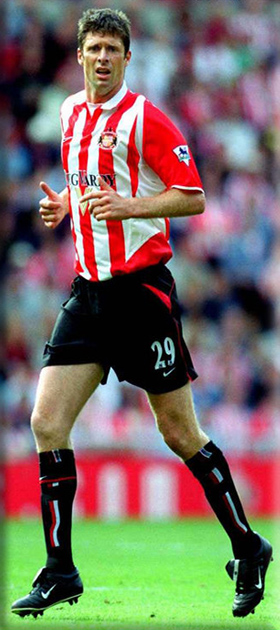
Niall Quinn - 1996 to 2002
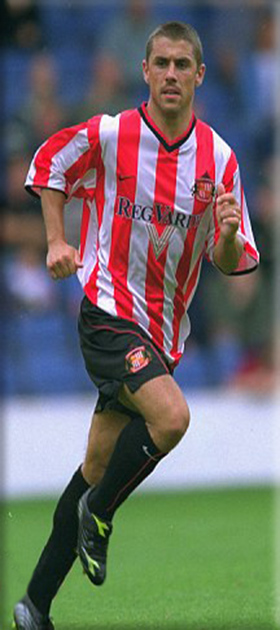
Kevin Phillips - 1997 to 2003
The Stadium Of Light

- Tennants: Sunderland A.F.C. (1997–present)
- Capacity: 48,707 - Opened: 1997
The Stadium of Light is an all-seater football stadium in Sunderland, England and home to Sunderland A.F.C. With space for 49,000 spectators, the Stadium of Light has the fifth-largest capacity of any English football stadium and the fourth-largest Premier League stadium. The stadium primarily hosts Sunderland A.F.C. home matches. According to Sir Bob Murray then chairman of Sunderland F.C. the name Stadium of Light "was chosen for 2 main reasons; namely as an ever-lasting tribute to the region’s mine-workers and proud industrial heritage and in the expectation that the stadium would be a guiding light in the future. The name is very much a symbolic link to the thousands of miners and Sunderland supporters that emerged from the darkness and into the light every day when they returned to the surface after working in the mine." A Davy lamp monument stands at the entrance to reflect the coal mining industry that brought prosperity to the town.
As well as hosting Sunderland games, the stadium has hosted two matches for the England national football team, as well as one England under-20 football team match. With an original capacity of 42,000, it was expanded in 2002 to seat 49,000, and its simple design is expected to allow for redevelopments up to an eventual capacity of 66,000. The attendance record at the Stadium of Light is 48,353 set on 13 April 2002, when Sunderland played Liverpool with the visitors running out 1–0 winners. Along with hosting football matches, the stadium has played host to performers such as Rihanna, Oasis, Take That, Kings of Leon and Coldplay. The ground also holds conference and banqueting suites, the Black Cats Bar, and a club shop selling Sunderland merchandise.
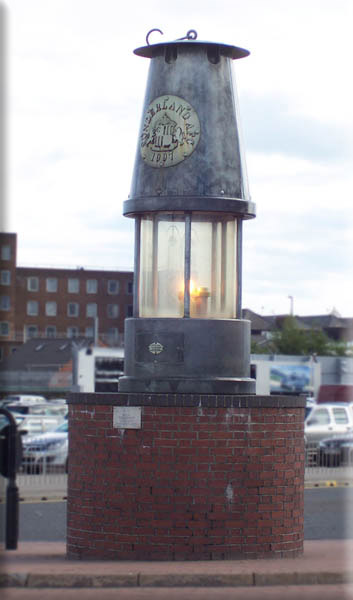 Planning and construction
Following the release of the Taylor Report in January 1990, Sunderland was obliged to make plans to turn their Roker Park home into an all-seater stadium. Roker Park was a ground that mainly consisted of standing terraces, and if converted into all-seater it would have held far fewer spectators than before. Enclosed by residential streets on all sides, expansion was practically impossible. So, by 1991, Sunderland chairman Bob Murray began investigating the possibility of relocation to a new stadium.
Planning and construction
Following the release of the Taylor Report in January 1990, Sunderland was obliged to make plans to turn their Roker Park home into an all-seater stadium. Roker Park was a ground that mainly consisted of standing terraces, and if converted into all-seater it would have held far fewer spectators than before. Enclosed by residential streets on all sides, expansion was practically impossible. So, by 1991, Sunderland chairman Bob Murray began investigating the possibility of relocation to a new stadium.
The front-runner that emerged was a proposed stadium located on an area of land adjacent to the Nissan car plant. The 49,000 all-seater ground was labelled "the Wembley of the North" – a capacity that not even Manchester United's Old Trafford exceeded until 1996. The plans did not come to fruition. Shortly after the plans were announced in 1992, Nissan launched an official objection, ultimately forcing Sunderland to abandon the idea. In 1995, Sunderland put forward a plan to build a stadium on the former site of Wearmouth Colliery. The area, on the north bank of the River Wear in the Sheepfolds district of Sunderland, was only a few hundred yards from Roker Park, and close to the centre of the city. On 13 November 1995, the Sunderland chairman Bob Murray announced that the Tyne and Wear Development Corporation had approved plans for Sunderland to build a 34,000-seater stadium on the site.
Ballast Wiltshier plc, a contracting company that had built the Amsterdam Arena, was contracted to build the stadium at an initial cost of £15 million. In June 1996, as the planned capacity rose to 40,000, construction work began. The capacity was revised again in early 1997, and the stadium was completed on time, with a capacity of 42,000.The stadium's design allows possible expansion of a further tier; completed expansion of the whole upper tier would produce a capacity of 63,000, although it is known that the stadium can expand to a maximum capacity of 84,000, this would never be exercised as the demand for space is at a minimum. During construction, the stadium had not adopted an official name, and had been known colloquially as the "Wearside Stadium" and "New Roker Park". The name was eventually revealed as the Stadium of Light, a reference to a miner's lamp (the stadium is built on the site of the old Wearmouth Colliery, and many Sunderland fans have worked in the region's mines). To emphasise the fact, a Davy lamp is located in front of the stadium's ticket office, adjacent to the stadium. The stadium was opened on 30 July 1997 by Prince Andrew, Duke of York, with bands such as U2, Status Quo, Upside Down and Kavana playing. To celebrate the opening of the stadium, Sunderland played a friendly against Ajax, which was drawn 0–0.
The North Stand was extended in 2000 to bring the capacity to 49,000, costing the club a further £7 million, making the final cost of the stadium £23 million. On 18 July 2006, a statue of 1973 FA Cup Final winning manager Bob Stokoe was unveiled. At the end of season Football League awards, the Stadium of Light was named the Best Away Ground, with other contenders including Crewe Alexandra's Alexandra Stadium and Plymouth Argyle's Home Park. Sunderland celebrated the tenth anniversary of the stadium with a pre-season friendly against Juventus on 6 August 2007; the game was drawn 1–1.
In November 2011, the club announced that the away supporters' section would be moved from the South Stand to the North Stand Upper from the beginning of the 2012–13 season. As a result, minor modifications to the ground will be necessary.
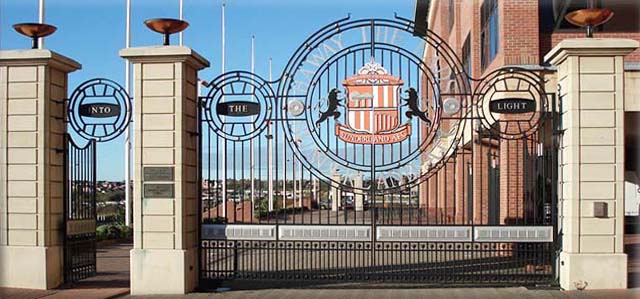
Structure and facilities
The stadium is in the shape of a square bowl, and is separated into the West Stand, North Stand, East Stand (formerly the Vaux Stand, the Carling Stand, and Fosters Stand respectively), and the South Stand (also known as the Metro FM Stand).
The West Stand includes the Premier Concourse which is the name of the upper tier, and a number of executive boxes. The North Stand also includes an upper tier, called the Strongbow Upper, which contains the Black Cats Bar.
The pitch is several metres below the level of the ground outside of the stadium. The pitch uses a lighting system from Stadium Grow Lighting to ensure the grass can grow at any time of year.
The device controls various aspects of the pitch, including exposure to light, temperature, water, and air, to make the grass able to grow in any conditions. Away fans were seated in the west half of the South Stand when the ground opened in 1997, in 2012, Ellis Short decided decided to move away fans to the Upper Tier of the North Stand The East Stand has the Sunderland emblem on the seats, while the North Stand has the slogan "Ha'way The Lads". The stadium also has a Davy lamp monument, and a statue of Bob Stokoe. The perimeter walls of the stadium incorporates a "Wall of Fame" feature, where names can be engraved into the bricks of the walls. The interior of the stadium holds a banqueting suite, which can seat from 460 to 600 people. The stadium also contains several conferencing suites, that can be hired for events.



















